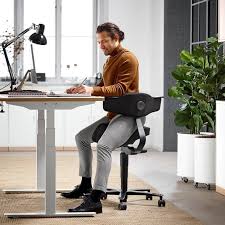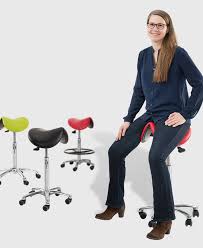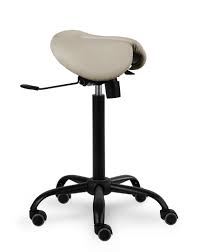

You know that all-too-familiar “tech hunch” — the head juts forward, shoulders round in like turtle shells, and the neck screams after hours of scrolling through your cellphone, typing, or binge-watching on devices.
This posture disaster, commonly dubbed text neck, is no longer just an occasional nuisance. It is a daily epidemic, and it is messing with your spine — big time.
But what if the solution was not some fancy stretching program or chiropractic marathon?
What if it was a chair — specifically, a saddle chair?
With its horseback-inspired design, the saddle chair is quietly riding into workplaces and home offices to rescue your neck from the tyranny of bad posture.
BestForwardHeadPostureFix would now explore how saddle chairs do not just support your back — they reprogram your entire spine to sit upright, naturally correcting that stubborn text neck.
This Article Covers the Following Points:
- The Text Neck Epidemic
- How a Saddle Chair Works
- Saddle Chair for Text Neck Relief
- Benefits of Saddle Chair Posture Correction
- Saddle Stool and Cervical Spine Alignment
- Text Neck Solutions Using Saddle Chairs
- FAQs on Saddle Chair for Neck Posture
- Riding-Like Sitting Benefits for Neck Posture
- Ergonomic Saddle Seating for Neck Pain
- Saddle Seat to Fix Forward Head Posture
- Conclusion: Ride Upright, Live Pain-Free
The Text Neck Epidemic
Let’s face it — modern life practically rolls out a red carpet for slouching.
Whether you are craning your neck to doomscroll Twitter, bingeing shows on a tablet, or answering emails like a productivity machine, chances are your head is jutting forward like a turtle escaping its shell.
But here is the plot twist: for every inch your head moves ahead of your shoulders, it dumps around 10 extra pounds of pressure onto your cervical spine.
Imagine carrying a bowling ball on a stick all day — that is your neck, begging for mercy. This seemingly harmless habit wreaks havoc over time.
Chronic neck pain? Check.
Knotted shoulders? Check.
Tension Headaches and shallow breathing? Double check.
And if you think your office chair is helping, think again — many are ergonomically about as useful as a beanbag. It is not just poor posture; it is a silent saboteur of your health, hiding in plain sight while you text.
How a Saddle Chair Works?
A saddle chair is not just a quirky office upgrade — it is a biomechanical game-changer. Here’s how:
- Mimics Horseback Posture:
Instead of slumping into a 90° hip angle like in standard chairs, saddle chairs position your hips at about 135°, similar to a rider in a saddle. This posture has been shown to reduce disc pressure in the lumbar spine (Mandal, 1985). - Pelvis Tilts Forward:
The seat encourages an anterior pelvic tilt, which aligns the lumbar curve (lordosis) — a foundational step in restoring spinal integrity. According to Spine journal (1994), anterior pelvic tilt significantly reduces lower back strain. - Spinal Curves Fall Into Place:
With the lumbar curve restored, the thoracic spine can extend instead of hunching, and the cervical spine (neck) stacks neatly above. The entire spinal column returns to its natural S-curve thereby relieving C2 neck pain. - Prevents Forward Head Posture (FHP):
A properly stacked spine makes it harder for your head to jut forward. In fact, research in Physical Therapy Science (2016) found that sitting with a forward-tilted pelvis reduces neck strain and FHP-related symptoms.
In short, saddle chairs trick your body into sitting smarter — without even realizing it.
Yeehaw, ergonomics!
Saddle Chair for Text Neck Relief
- Promote Forward Pelvic Tilt
- The sloped design of the saddle chair encourages the pelvis to tilt slightly forward (anterior tilt).
- This is the opposite of the posterior tilt seen in regular chairs, which flattens the lumbar curve and encourages slouching.
- Restore Natural Spinal Curves
- The forward pelvic tilt restores the natural lordosis (inward curve) of the lumbar spine.
- A well-aligned lumbar spine allows the thoracic (mid-back) and cervical (neck) regions to follow their natural curves.
- Encourage Upright Posture
- With the spine correctly aligned, the head stacks directly over the shoulders.
- This reduces the tendency for the head to jut forward — a hallmark of text neck and forward head posture (FHP).
- Reduce Neck and Shoulder Strain
- Each inch of forward head posture adds about 10 pounds of extra load on the cervical spine.
- By preventing this shift, saddle chairs significantly reduce muscle strain and spinal compression in the neck.
- Re-train Postural Habits
- Regular use promotes proprioceptive awareness — the body’s internal sense of position.
- Over time, users naturally adopt and maintain better posture, even outside of seated activities.
Benefits of Saddle Chair Posture Correction
Posture correction is not just about standing taller or looking more confident — it is a full-body investment.
Proper alignment reduces muscle fatigue, enhances blood circulation, and relieves pressure on the intervertebral discs, especially in the lower back and neck.
Saddle chairs take this a step further by encouraging continuous micro-movements.
Unlike conventional chairs that promote rigidity, saddle chairs subtly activate your core, glutes, and back muscles to maintain stability.
This gentle engagement prevents muscular stagnation and promotes balance along the entire spine.
One standout benefit?
You do not need to constantly remind yourself to “sit up straight.”
The ergonomic design of the saddle chair does the work for you.
Its tilted seat naturally positions your pelvis and spine into optimal alignment, eliminating the chronic tug-of-war between muscles that occurs with slouched seating.
It transforms passive sitting into active posture reinforcement — all without you needing to think about it.
Saddle Stool and Cervical Spine Alignment
I am about to reveal the connection between this special chair and your neck/head posture in 5 easy-to understand points:
The cervical spine (neck region) is highly susceptible to postural strain, especially during prolonged sitting. Forward head posture increases the effective weight of the head on the neck from 10–12 pounds to as much as 60 pounds, according to research by Kapandji (Physiology of the Joints, Volume III).
Sitting on a saddle stool promotes neutral pelvic tilt, which naturally stacks the spine from the sacrum to the cervical vertebrae. This upright posture minimizes thoracic kyphosis and supports cervical alignment.
This upright spinal stacking reduces anterior translation of the head, allowing it to rest over the shoulders instead of hanging forward — a position strongly associated with cervical disc compression and muscle fatigue.
Studies show that ergonomic saddle chairs reduce neck and shoulder pain in office workers by facilitating dynamic sitting and proper spinal alignment (Journal of Occupational Rehabilitation, 2012).
Even small improvements in head posture significantly reduce neck strain, helping to prevent long-term musculoskeletal disorders.
Text Neck Solutions Using Saddle Chairs
Many of the so-called “solutions” for text neck — foam rollers, massages, posture braces, or those chin-tuck gadgets that make you look like you are preparing for liftoff — focus only on temporary relief.
Sure, they might ease tension for a few hours, but they do not fix the root problem: the way your spine and pelvis are positioned while you sit.
Saddle chairs, on the other hand, take a smarter approach. They start where posture problems begin — at the hips and pelvis.
By tilting the pelvis forward and opening up the hip angle, these chairs reset the alignment of your entire spine. This corrects the chain reaction that leads to forward head posture and neck strain.
It is a bottom-up strategy that makes a top-down difference. Unlike stretching routines you forget by lunch, saddle chairs work while you work. You do not need a yoga mat, therapist, or time off — just a chair that knows what your spine really wants.
FAQs on Saddle Chairs for Neck Posture Correction
Q-1: What’s the core biomechanical reason a saddle chair encourages an upright torso?
A-1: The saddle raises the hips and opens the hip angle to roughly 110–135°, which gently tips the pelvis forward.
That pelvic position helps maintain the spine’s natural lumbar curve, so the ribcage stacks over the pelvis instead of collapsing. With the “S” curve preserved, your trunk balances with less muscular bracing.
Q-2: Do saddle chairs actually change spinal curves compared with flat seats?
A-2: Typically, yes. The opened hip angle promotes more lumbar lordosis than a flat stool or low chair. One caveat: if your screen is too low or far away, your neck may still creep forward. The seat can set you up well, but you still need eye-level viewing to keep the head from “hunting” the screen.
Q-3: Why do my shoulders and neck feel quieter on a saddle seat during desk or clinical tasks?
A-3: With the pelvis tipped and torso more vertical, your elbows can rest closer to your sides. That reduces shoulder protraction and shrugging—two habits that tug the head forward.
A compact reach zone (keyboard, mouse, tools close-in) then limits the tiny forward leans that add up to neck strain across the day.
Q-4: Is a forward-tilted or “pelvic support” seat pan necessary, or is saddle shape enough?
A-4: The saddle shape often builds the tilt in, helping you keep a gentle anterior pelvic tilt without effort. For non-saddle chairs, a slight forward slope can imitate the effect.
What matters is matching height and tilt so you feel the sit bones contact, thighs sloping down, and the low back naturally arched—not forced.
Q-5: Are posture benefits universal, or can a saddle backfire for some users?
A-5: Not universal. Many users feel more supported through the low back, but those with very flat or painful lumbar spines—or poor screen positioning—may still experience neck protraction or discomfort.
Task demands matter too: if you twist or reach asymmetrically, chair benefits shrink. Fit, foot stance, and workstation layout remain the biggest levers.
Q-6: What setup details lock in the “upright” benefit day to day?
A-6: Set height so thighs angle downward and feet land wide for tripod balance.
Keep keyboard/mouse at standing elbow height relative to your seated posture, elbows near your sides. Center the monitor at arm’s length, with the top at or slightly below eye level. Recheck with a side photo: ears should hover closer over shoulders, chin less poked.
Add a micro-reset every 45–60 minutes—relax shoulders, exhale slowly, and “grow tall”—to make the stacked posture your default.
Riding-Like Sitting Benefits for Neck Posture
The genius of saddle chairs lies in their unique “riding-like” sitting position — think horseback riding, not office-chair slouching. Instead of collapsing into your seat or teetering on the edge, you adopt an active and balanced posture.
Your hips open to around a 120–135° angle, your thighs slope downward, and your pelvis tilts gently forward. This naturally engages your core muscles and restores the spine’s S-shaped curves — from the lower back to the neck.
This upright positioning does more than just make you look poised. It prevents your chest from caving in and your shoulders from rounding forward — two of the biggest culprits behind head-forward posture. With the thoracic spine (mid-back) held in an open and supportive position, your neck is no longer forced to strain or compensate.
Instead of carrying the weight of your head alone, your whole spine shares the load.
The result?
Less tension, better alignment, and posture that practically supports itself.
Ergonomic Saddle Seating for Neck Pain
Professionals who spend long hours seated — like dentists hovering over patients, surgeons bent over the operating table, or artists hunched at easels — have embraced saddle stools for very practical reasons.
These chairs reduce the repetitive postural stress that leads to chronic neck, shoulder, and lower back pain.
In fact, studies on dental professionals have shown that saddle stools significantly lower musculoskeletal strain and improve posture during procedures (Journal of Back and Musculoskeletal Rehabilitation, 2014).
Traditional chairs often encourage slouching or leaning into the backrest. While this might feel relaxing, it disengages the core and shifts the burden of holding up your upper body entirely onto your neck and shoulder muscles. Over time, this leads to fatigue, stiffness, and chronic tension.
Saddle chairs flip that script. With no backrest to slump against, they nudge you into an active, upright position. Your spine aligns naturally, your core stays lightly engaged, and your neck is supported by structure, not strain.
Saddle Seat to Fix Forward Head Posture
Forward head posture (FHP) does not happen overnight — it is the result of months or even years of slouching over screens, steering wheels, or sketchpads.
And just like it took time to develop, correcting it requires consistent, daily support. That is where saddle seating shines. By positioning the pelvis in a more neutral, slightly forward-tilted angle, the saddle seat restores the natural curvature of the spine — especially in the lumbar region.
This upright foundation gently shifts the head back into proper alignment, reducing the tendency to crane forward.
Users often report that, without even trying, they stop leaning into their laptops or hunching over their phones. Instead of collapsing through the chest and neck, they engage their core and sit tall — whether they are typing emails, drawing, or performing dental procedures.
It is not magic, and it is not a quick fix. It is the long-game of smart biomechanics — using a simple seat to rebuild posture, one hour at a time.
Takeaway: Ride Upright, Live Pain-Free
Text neck is the silent villain of modern life — creeping in with every scroll, swipe, and slouch. It is responsible for chronic neck pain, headaches, and tension in millions of screen-bound individuals.
But the fix does not require wearable gadgets, restrictive braces, or weekly spine-cracking appointments. Sometimes, the solution is surprisingly simple: sitting smarter.
Saddle chairs provide that smarter option. Unlike traditional seats, they position your pelvis in a slightly forward tilt, which reactivates the natural S-curve of your spine. This upright alignment reduces the forward pull on your neck and shifts your center of gravity back where it belongs — over your hips, not your toes.
With regular use, saddle chairs help retrain your posture automatically. They activate core muscles, reduce upper-body tension, and promote vertical stacking of the spine, making slouching physically harder. In effect, they turn your workstation into a daily postural therapy session.
If your neck is begging for mercy, it might be time to trade your office chair for a saddle. Your spine — and your screen-weary soul — will thank you.
References:

